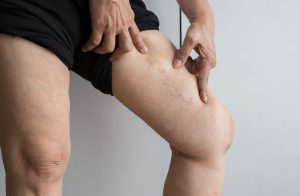How Can I Prevent Spider Veins and Varicose Veins?
 Most men and women will experience spider veins and varicose veins sometimes in their lifetimes. It’s “normal” in that it can happen regardless of your lifestyle, health, and regular activities. While it can happen to anyone, the risk factors can affect the appearance of your legs and cause pain and discomfort.
Most men and women will experience spider veins and varicose veins sometimes in their lifetimes. It’s “normal” in that it can happen regardless of your lifestyle, health, and regular activities. While it can happen to anyone, the risk factors can affect the appearance of your legs and cause pain and discomfort.
While varicose veins do affect more than 40 million people in the US, you should be aware of the risk factors that make you a more likely candidate. At Vanishing Vein Northwest, our goal is also to help you understand how you can often prevent worsening spider veins and varicose veins.
Causes of Spider Veins and Varicose Veins
The root cause of varicose veins and spider veins is damage to your valves or weak veins. Instead of circulating like it normally should, your blood may pool in your veins, which then become more easily visible.
Here are some of the risk factors that may contribute to varicose veins and spider veins.
- Age: As you get older, the valves in your legs may become weaker.
- Hormones: Women develop spider veins and varicose veins in higher numbers, with hormonal changes possibly increasing your risk.
- Family History: Genetics do play a role in developing varicose veins and spider veins.
- Activities: If you sit or stand for long periods of time, you may be at a higher risk of developing spider veins and varicose veins.
These risk factors and circumstances can exacerbate and contribute to your development of varicose veins, spider veins, or even venous insufficiency (CVI). You may notice that your veins look like cords or have a spidery appearance.
Ways to Prevent Spider Veins and Varicose Veins
If you’ve noticed the first signs of varicose veins and spider veins, the first step is to alleviate the itching or aching that may already be accompanying their appearance. Here are a few ways to prevent varicose veins and spider veins from developing or worsening.
- Elevate Your Legs: At the end of a long day, or after standing for a long period of time, you can put your legs up to help support the blood flow to your legs.
- Use Compression: Compression socks are another great way to help promote healthy blood flow in your legs, which can ease some of the itching or aching.
- Exercise: Gentle walking or other light exercises can help to stimulate your blood flow, which can prevent the appearance of spider veins and varicose veins in some cases.
While these activities and actions can help to increase blood circulation, you may still see signs of varicose veins and spider veins. If they become more uncomfortable and painful, consult with your doctor.
Next Step: Consult with Vanishing Vein Northwest
At Vanishing Vein Northwest, our goal is to help you to prevent spider veins and varicose veins. We work toward that goal by helping you to understand how your lifestyle choices can contribute to the development of varicose veins and spider veins.
We consult with you about all the options, with vein treatments being one of the solutions that we explore as a balanced approach to your health and overall wellness. We discuss your medical history, your family’s history, and explore the affordable options that give you the legs you love. Call us to find out how we can help.